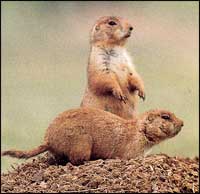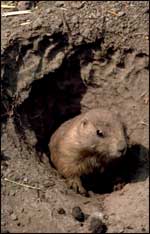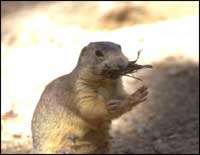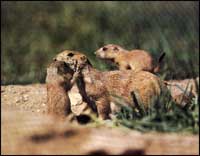Prairie Dogs

Prairie dogs sit up frequently, on the lookout for any danger.
Mornings are a busy time in a prairie dog town as the residents come out to eat the grasses and weeds growing near their burrow entrances. These chubby members of the ground squirrel family seem to lead relaxed, sociable, uncomplicated lives as they wander about eating, visiting with their neighbors, or indulging in playful antics. However, they constantly are alert to danger, sitting up frequently to observe their surroundings. Their black-tipped tails are rarely still, swishing back and forth at a rate dependent upon their degree of excitement or fear. And although their bodies may be roly-poly, they are capable of making lightning-quick moves and split-second dives into the safety of their burrows. Before they leave their burrows, their heads pop up to scan the horizon in all directions.
The tunnels in the burrow system may range in length from twelve feet to more than a hundred feet. The main entrance tunnel goes straight down for twelve to fourteen feet, with a listening-post chamber close enough to the surface to hear, but deep enough to protect the listener. One or more passages run horizontally from the main tunnel and lead to chambers for food and refuse. There also is a grass-lined chamber for rearing the young. Lateral passages form pockets that help trap air when other portions of the burrow might be flooded. The tunnel system connects with at least two holes above the ground to provide ventilation and escape routes.

The mother prairie dog takes grass down into the burrow to build a nest for the young, which are born in litters of four or five during March or April.
When the temperature range above ground is 77 to 99 degrees Fahrenheit, temperatures inside the burrow are more moderate, ranging from 80 to 89 degrees. When winter temperatures range from 25 to 44 degrees Fahrenheit, burrow temperatures will be 42 to 48 degrees. During the hottest hours of a summer day, the prairie dogs retire to their cooler burrows to nap or carry out other underground activities. But when evening comes, they once again return to the surface to eat. In winter, prairie dogs venture above ground to feed while the sun's rays are the warmest. During really bad weather they sleep (but do not hibernate), living off body fat when there are no stored food supplies.
Communication is an integral part of the prairie dog's daily life. The animals are quite vocal and have a variety of shrill whistles and barks for different situations. During their above-ground activities, one or more of the animals are on sentry duty, sitting atop their mounds ready to sound a warning to the entire community. At the first sign of danger, the sentry makes a sharp, warning bark. The other prairie dogs race to their burrows, sit up, and join in with the warning cry to spread the word. If the situation warrants it, each family member, one by one, dives into the security of the burrow, leaving a deserted-looking town for the intruder. When danger is past, the sentry gives a songlike all-clear bark and the others again join in to spread the word. Another interesting vocalization is the territorial call. To make this call, the prairie dog thrusts its body upward full-length, points its nose in the air, and stretches out its forelegs. Since this is a quick, powerful movement, the first few times a young prairie dog attempts the territorial call, it often tumbles over backwards.

To make the territorial call, the prairie dog quickly thrusts its body upward full length, nose in the air and forelegs outstretched.
A prairie dog's home territory is determined by the coterie (KOTE-uh-ree) to which it belongs. Just as a city is divided into neighborhoods, the prairie dog town is divided into coteries. Each coterie, which usually contains one male, several females, and six or more young (not necessarily related), has its own territory to defend and has the use of the burrow system within this territory. Although there is communication between coteries, members do not invade each other's territories. Every member of the coterie knows every other member. They keep in touch and reinforce recognition by frequently grooming each other and "kissing" (touching noses and teeth). They have a greeting kiss and recognition embrace. It is not unusual to see a pair sitting side by side with the arm of one over the shoulder of the other.
When two prairie dogs meet, they touch their bared teeth together. If one is not a fellow coterie member, the intruder is sent on its way. Coterie members turn the touched bared teeth into a sort of kissing action and then may wrestle each other playfully. Their nuzzling, wrestling, and grooming antics are what make the prairie dogs such entertaining creatures to watch.

Prairie dogs are sociable creatures, and their nuzzling and grooming antics make them entertaining to watch. Their "kissing" behavior (touching of noses with bared teeth) is the way the identify members of their own coterie.
Young prairie dogs are born in March and April. They first appear above ground when they are about six weeks old. They are weaned shortly after, and by the time they are three months old, the family ties are broken. They become sexually mature in the second year. At one time prairie dog towns were enormous – one in Texas is reported to have covered twenty-five thousand square miles and housed some 400 million prairie dogs. Sharing their burrow system (not necessarily as invited or welcomed guests) were a number of other animals. However, the three most common intruders were the black-footed ferret, the burrowing owl, and the rattlesnake.
The black-footed ferret's long, weasellike body was perfect for entering and exploring the complex maze of burrows in search of its prey – prairie dogs. Its range, of course, was the same as that of the prairie dog. Unfortunately, when ranchers declared war on the prairie dog because its burrow holes were a menace to livestock and it competed with cattle for vegetation, the ranchers also in-advertently attacked the ferret. They not only destroyed its food source, but the poison and gas that were used to kill the prairie dogs also killed the ferrets. At this time, the black-footed ferret is considered the rarest mammal in North America and appears on both state and federal endangered species lists. It is doubtful if a single one can be found in Texas.
The burrowing owl was not hurt as badly by the extermination of so many prairie dogs as the ferret. The owls lost a few eggs and chicks to the resident prairie dogs, and the owls ate a few young prairie dogs. However, young prairie dogs were not the owl's main food, and it could dig its own burrow with its sharp talons and long legs. It just found the ready-made burrows less work than digging its own. Rattlesnakes were even less dependent on the prairie dogs for survival. The burrows were a cool place for the snakes to go to get out of the hot sun, and they also provided den sites, where rattlesnakes could gather and hibernate until spring. Of course, the snakes probably ate a share of the young prairie dogs and the burrowing owl chicks and eggs. Heat-sensitive facial pits made it possible for the rattlesnake to find its prey in even the darkest tunnel system. However, when the prairie dogs discovered a snake's presence, they escaped through the emergency exit, circled back to the hole where the snake entered, and, with the help of their prairie dog neighbors, filled in the hole, burying the snake alive. Other predators that include prairie dogs on their menu are eagles, hawks, coyotes, bobcats, and badgers.
Vast prairie dog towns with millions of inhabitants are a thing of the past, but a few preserved colonies, such as the one at Mackenzie State Park, ensure that we will be able to watch the prairie dog and enjoy its antics into the future.
Ilo
Hiller
1990 – Prairie Dogs: Introducing Mammals to Young
Naturalists. The Louise
Lindsey Merrick Texas Environment
Series, No. 10, pp. 47-52.
Texas A&M University
Press, College Station.